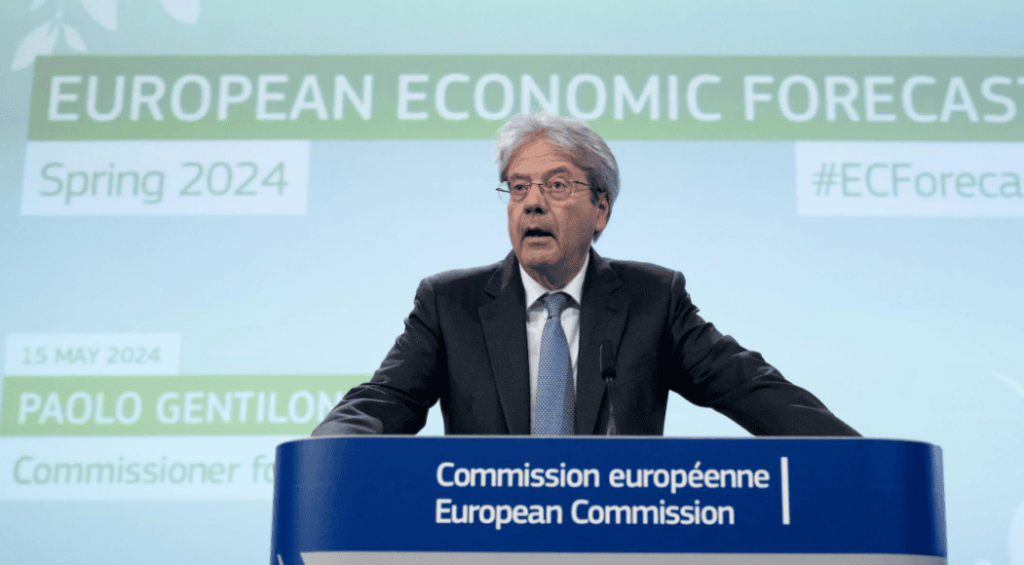Following a period of broad stagnation, the EU economy staged a comeback in the first quarter of 2024. This column argues that despite a challenging external environment, strong domestic fundamentals set the stage for gradual acceleration of economic activity. However, member states’ budgetary positions remain burdened by the legacy of the pandemic and the energy crisis and the aggregate EU government debt ratio is projected to increase slightly next year, pointing to a need for fiscal consolidation. The reformed EU economic governance framework will allow steering the consolidation process, with a focus on strengthening member states’ debt sustainability, while promoting growth-enhancing reforms and investment.
The EU economy largely stagnated last year…
2023 was a challenging year for the EU economy. Even though energy gas prices began declining in the second half of 2022, their gradual and persistent pass-through pushed up core inflation, in turn prompting a forceful tightening by monetary authorities (Lane 2024). The disinflationary efforts of EU central banks were accompanied by a gradual withdrawal of fiscal measures taken to buffer the energy inflation shock. Private investment activity progressively came to a halt, dragged by a severe downsizing of the rate-sensitive-residential construction. Consumption expanded only moderately as households saved a larger share of their disposable income to reduce their debt level, rebuild wealth buffers or benefit from higher returns on financial assets. External demand also faltered, as global goods trade slumped. Meanwhile, HICP inflation has continued declining. From a peak of 10.6% in October 2022, inflation in the euro area is estimated to have reached 2.4% in April 2024. Inflation in the EU followed a similar path, though remaining slightly higher. The rapid fall in retail energy prices throughout 2023 was the main driver of the inflation decline, but underlying inflationary pressures started easing too in the second half of 2023, amidst the weak growth momentum.
…but staged a comeback in the first quarter and the conditions for gradual expansion are largely in place.
The 0.3% rebound in real GDP growth in the first quarter of the year has set the EU economy on the previously expected modest expansion path. The expansion has been broad-based across countries. Looking forward, the macroeconomic fundamentals are conducive to growth. Labour markets entered the year on a strong footing on the back of favourable demand and supply conditions. Notwithstanding signs of weakening, employment is set to keep expanding, while wage growth coupled with the ongoing decline in inflation are set to support a recovery of real wages – which by 2025 are expected to regain their 2021 level, on aggregate in the EU. High financing costs are set to continue dragging corporate investment and especially residential construction. However, markets expect a gradual easing of monetary policy starting soon in the euro area, while outside the euro area, central banks in some central and eastern European countries as well as Sweden have already started to ease monetary conditions.
Gradual expansion ahead amid slowing inflation
According to the European Commission Spring 2024 Forecast (European Commission 2024a), continued wage and employment growth will sustain growth in disposable income in 2024. Nonetheless, increasingly widespread intentions to save reported by consumers in the Commission surveys (European Commission 2024b) suggest that the expansion of private consumption will continue to be restrained by a further uptick in the saving rate to 14.4%. In 2025, real disposable income is set to accelerate further, while the decline in interest rates reduces incentives to save. This is set to deliver a more sustained consumption growth of 1.7%.
Figure 1 Real household gross disposable income and private consumption growth


Figure 2 Investment growth and its composition by asset type


Evidence from the Commission business surveys and the Bank Lending Survey by the ECB (ECB 2024, European Commission 2024b) (which reports low demand for loans by firms) point to a subdued outlook for corporate investment. With prolonged weakness in the manufacturing sector leaving many plants operating below normal capacity utilisation rates, equipment investment is expected to expand only marginally this year, before accelerating in 2025. Non-residential construction investment is expected to remain resilient, largely reflecting government infrastructure spending with RRF support. By contrast, housing investment is projected to continue contracting as a continued fall in house prices and a still large build-up of inventories weigh on supply. The downsizing of residential construction is set to continue in 2025, but the aggregate outlook masks significant variation across countries. Finally, as global trade elasticities normalise, demand for European goods should gather pace, while the inventory cycle is unlikely to continue to significantly detract from economic activity.
Disinflation set to continue, driven by slowing core inflation
Overall, this Spring Forecast projects slow but steady growth amid further declining inflation. Real GDP growth in 2024 is forecast at 1.0% in the EU and 0.8% in the euro area. In 2025, it is forecast to accelerate to 1.6% in the EU and 1.4% in the euro area – marginally down from the previous forecast. Importantly, almost all Member States are expected to return to growth in 2024. HICP inflation is projected to continue declining over the forecast horizon, mainly thanks to lower food and non-energy industrial goods prices. In the EU, it is now expected to decrease from 6.4% in 2023 to 2.7% in 2024 and 2.2% in 2025. In the euro area, it is forecast to fall from 5.4% in 2023 to 2.5% in 2024 and 2.1% in 2025. Services have so far contributed very little to the disinflation process, reflecting still elevated wage pressures. Wage growth is set to continue slowing down over the forecast horizon, but to remain above inflation. The deflationary process therefore rests on an uptick in productivity and overall subdued growth in profit margins.
Figure 3 Composition of real GDP growth in the EU


Figure 4 HICP inflation in the EU by component


The new EU fiscal governance framework will guide a sustainable reduction of still high government debt
After a sizeable reduction in 2022, the EU government deficit in 2023 increased marginally from 3.4% to 3.5% of GDP, as the economy stagnated and increased interest expenditure outweighed the reduced cost of discretionary policy. The EU government deficit is nevertheless projected to resume declining in 2024 (to 3.0%) and 2025 (to 2.9%), driven by the almost complete phase-out of energy-related support measures, lower subsidies on private investment as well as the gradual improvement in economic activity. Amid higher costs of servicing debt and lower nominal GDP growth, the debt-to-GDP ratio is instead set to stabilise this year, at 82.9% in the EU, before edging up by around 0.4pps. in 2025, with important variations across Member States. Overall, these projections point to a need for fiscal consolidation (Thygesen et al. 2023).
Figure 5 Aggregate general government balance and debt


Figure 6 General government balance in EU Member States


As of this year, multilateral fiscal surveillance will be governed by the new EU governance framework that entered into force on 29 April. 1 The objectives of the reformed framework are public debt sustainability, and sustainable and inclusive growth through reforms and investments. To this purpose, it has a greater medium-term focus compared to the previous surveillance framework.
A central novelty of the reformed framework is that Member States will submit by this autumn their first medium-term fiscal-structural plans. In these, Member States will commit to expenditure paths that bring their government debt onto a sustainable path. In particular, they will set a maximum growth rate of net nationally financed primary expenditure, defined as government expenditure excluding interest expenditure, expenditure matched by revenue from EU funds (including also national co-financing), and net of the impact of revenue measures. As an initial step for the preparation of their plans, the Commission will define reference expenditure trajectories for those Member States with projected deficit or debt ratios above the thresholds of 3% and 60% of GDP. They are based on the debt sustainability assessment for each country, which in turn hinges upon the Commission’s estimates of potential growth and the structural primary balance, based on the forecast – as well as the expected developments in interest expenditures and projected ageing-related expenditure. 2
The Spring Forecast does not yet include the impact of the forthcoming medium-term plans. By default, the Commission forecasts assume unchanged policies (European Commission 2016), i.e. they do not include a reaction function for the government (even in cases where such a reaction is very likely), nor do they assume compliance with fiscal rules (neither domestic nor EU based). Fiscal policy measures are only included once they have been credibly announced and specified in sufficient detail. This implies that measures to ensure compliance with the fiscal targets from the medium-term plans will only be incorporated in the Autumn Forecast, once the plans and corresponding budget proposals for 2025 are known. Other things being equal, their implementation can be expected to translate into a more restrictive fiscal stance than currently projected and thus a lower growth outlook for 2025.
Despite the downside risks to short-term growth they pose, these fiscal consolidation efforts are key to rebuild buffers that – as seen in previous years – are of crucial importance when facing unexpected crisis.
Source : VOXeu



































































